National World War II Memorial
Introduction
Author-Uploaded Audio
Listen to the history behind the memorial from Clio founder David Trowbridge
Text-to-speech Audio
Opened in 2004, the World War II Memorial honors the 16 million who served in the United States Armed Forces, the more than 400,000 members who made the ultimate sacrifice, and the millions who supported war efforts on the home front. This is the only memorial related to an event in the 20th century that appears in the central axis of the National Mall. It is part of the National Park Service's National Mall and Memorial Parks.
Images
The National World War II Memorial is expansive, much like the war itself, but uses symmetry, flowing water, and inscriptions to indicate unity.
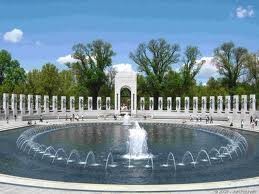
The Rainbow Pool, named for the colored rays that appeared in the sunshine, was built in 1912 and later incorporated in the National World War II Memorial. Photo courtesy of the Library of Congress.
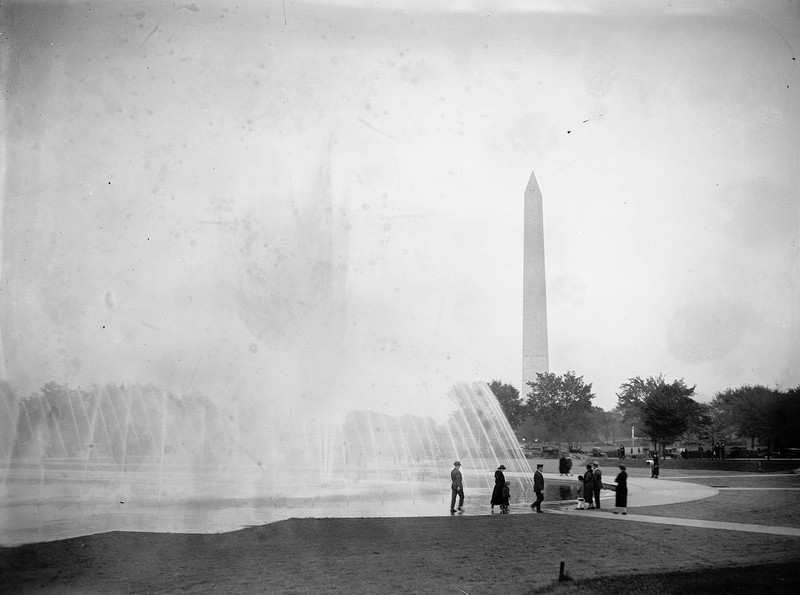
The Atlantic Arch commemorates those who fought in European countries. Photo courtesy of Sdwelch1031 on Wikimedia.
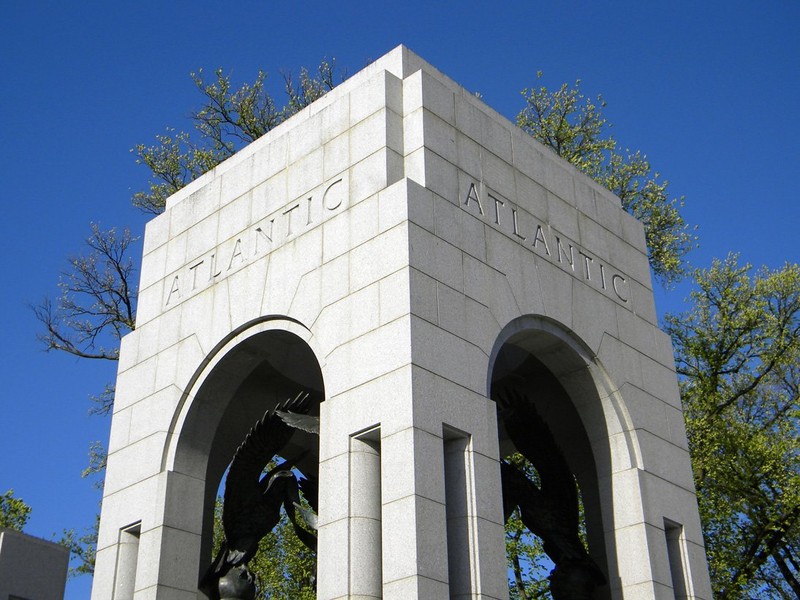
The Pacific Arch commemorates the island hopping campaigns against Japanese forces. Photo courtesy of Sdwelch1031 on Wikimedia.
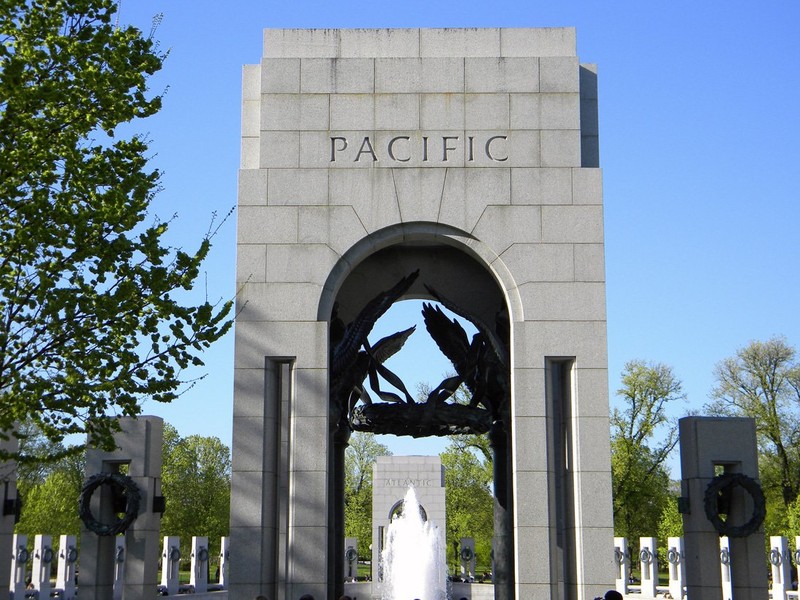
24 bas-relief panels tell stories from the war, such as this image of a field hospital. Photo courtesy of the National Park Service.
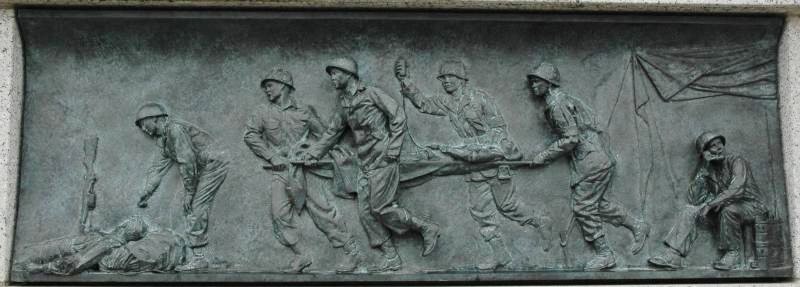
On the Price of Freedom memorial, each of the 4,048 gold stars represents 100 service personnel who gave the ultimate sacrifice. Photo courtesy of dbking on Flickr.
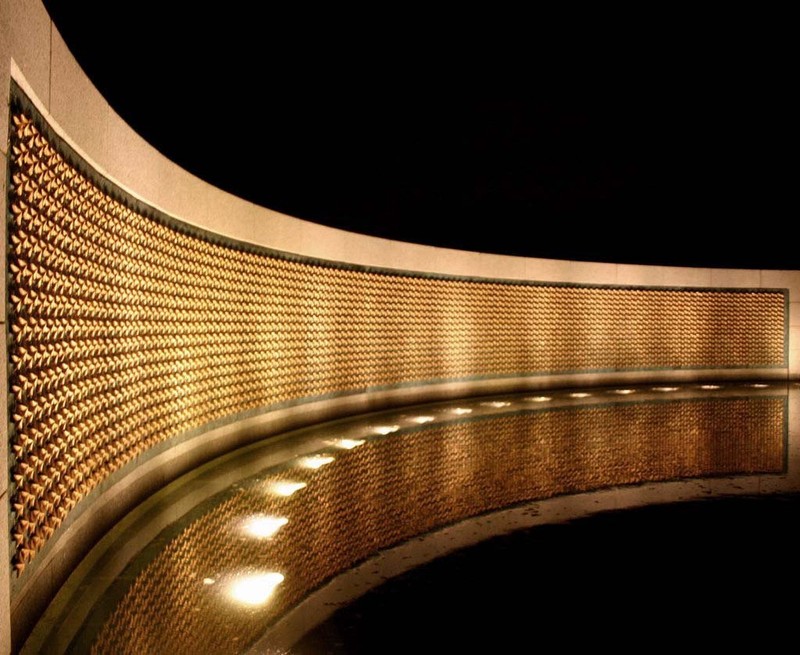
An aerial view of the National World War II Memorial.
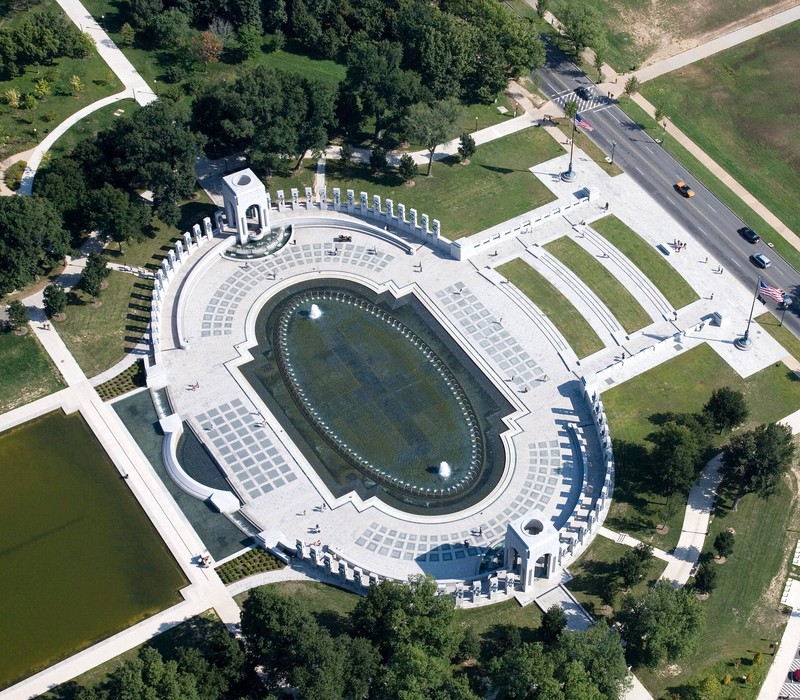
Backstory and Context
Text-to-speech Audio
The National World War II Memorial commemorates the United States' involvement in the deadliest and most widespread conflict in history. Between 1939 and 1945, Allied powers fought against the Axis powers' authoritarian and fascist regimes. The United States entered the war after the Japanese bombed a military base at Pearl Harbor, Hawaii, on December 7, 1941. Soldiers and civilians mobilized to support the war, sacrificing their resources, time, and sometimes their lives.
The first efforts to build a World War II memorial began in 1987, with veteran Roger Durbin and Ohio Representative Marcy Kaptur. After multiple unsuccessful attempts, legislation passed in the Senate and House in 1993 to establish a national memorial. On May 25, 1993, President Bill Clinton signed the World War II Memorial Act into law. This law gave the American Battle Monuments Commission (ABMC), an independent federal organization, and a Memorial Advisory Board (MAB) authority to develop the project. For the next eleven years, these authorities partnered with other organizations, including the National Park Service, the Commission of Fine Arts, the National Capital Planning Commission, the U.S. Army Corps of Engineers, and the General Services Administration.
Choosing the memorial's location was one of the earliest and most important decisions. Congress passed a joint resolution in 1994, allowing the memorial to be built within the bounds of the National Mall. Protected by the National Park Service and nicknamed "America's Front Yard," the National Mall preserves and interprets to the world "the symbols and icons of our nation and its ideals." But choosing where on the National Mall, a space already cramped with monuments, museums, and tourists, would be a challenge. Seven sites around the National Mall were up for consideration. After almost a year, the involved organizations decided on a site between the Washington Monument and Lincoln Reflecting Pool. This open and central space would make the National World War II Memorial a very prominent part of the National Mall. Design plans would also incorporate the existing Rainbow Pool designed by Frederick Law Olmsted, Jr. and Henry Bacon.
With the location chosen, the next step was to find a winning design. Throughout 1996, more than 400 entries were submitted to an open competition. The ABMC and General Services Administration chose a grand proposal by Friedrich St. Florian, an Austrian-American architect. Because this memorial held great significance, debates continued over the location and design. Various stakeholders argued the memorial was too large, interrupted the view between the Washington Monument and the Reflecting Pool, and eliminated an open space traditionally used for demonstrations. Despite some criticism, construction began in September 2001 and moved quickly, as many expressed concern about losing veterans and witnesses to the war. Senator Bob Dole, a veteran, and Frederick W. Smith led the fundraising campaign that totaled $197 million; the federal government provided $16 million, and the rest came through generous donations.
In April 2004, the National World War II Memorial opened to the public. In May, the memorial was dedicated in a ceremony with 150,000 attendees. The ABMC transferred ownership to the National Park Service, which maintains, operates, and interprets the memorial. Since 2007, the memorial has also been supported by the Friends of the National World War II Memorial, a nonprofit that raises funds and plans events such as observances of Veterans Day and Memorial Day.
The memorial's large, sunken terrace and loud fountains give a powerful sense of the magnitude of war and the determination of its victors. The modified Rainbow Pool is the memorial's central feature, where water from surrounding fountains seems to join together. Though common in other parts of the National Mall, the National Park Service prohibits wading in the fountains of this monument.
The pool is flanked by two granite arches symbolizing the war's Atlantic and Pacific Theatres. Encircling the memorial are 56 granite pillars, each representing U.S. states and territories involved in the war. One of the most prominent features of the memorial is the Price of Freedom Wall, which has 4,048 stars. Each of these stars represents 100 Americans killed in the war. Along the entrance walls, bronze bas-relief panels tell stories of American soldiers and citizens, depicting scenes such as military battles, preparing supplies and armaments, war bond drives, and victory.
Sources
1. "About the Memorial, " Friends of the National World War II Memorial; "Chronology," Friends of the National World War II Memorial.
2. National Park Service, "Foundation Statement for the National Mall...," 2.
3. "About the Memorial, " Friends of the National World War II Memorial; "Chronology," Friends of the National World War II Memorial.
4. "About the Memorial, " Friends of the National World War II Memorial; "Chronology," Friends of the National World War II Memorial.
5. "About the Memorial, " Friends of the National World War II Memorial.
6. National Park Service, "History and Culture," National Mall and Memorial Parks; Savage, Monument Wars, 289-300.
Friends of the National World War II Memorial. "About the Memorial." Friends of the National World War II Memorial. Accessed September 2017. http://www.wwiimemorialfriends.org/the-memorial/about-the-memorial
Friends of the National World War II Memorial. "Chronology." Friends of the National World War II Memorial. Accessed September 2017. http://www.wwiimemorialfriends.org/the-memorial/chronology
National Park Service. "Foundation Statement for the National Mall and Pennsylvania Avenue National Historic Park." National Mall and Memorial Parks. Accessed September 2017. https://www.nps.gov/nationalmallplan/Maps/NMMParks_map.pdf
National Park Service. "History and Culture." National Mall and Memorial Parks. Accessed September 2017. https://www.nps.gov/wwii/learn/historyculture/index.htm
Savage, Kirk. Monument Wars: Washington, D.C., the National Mall, and the Transformation of the Memorial Landscape. University of California Press: 2009.
Images:
"Rainbow pool at Lincoln Memorial." Glass negative. Circa 1924. Library of Congress Prints and Photographs Division Washington, D.C. Accessed September 2017.
http://www.loc.gov/pictures/item/npc2008006839/
Wikipedia. "National World War II Memorial." Wikipedia. Last modified September 5, 2017. Accessed September 2017. https://en.wikipedia.org/wiki/National_World_War_II_Memorial
National Park Service. "Scenes of WWII." National Mall and Memorial Parks. Accessed September 2017. https://www.nps.gov/media/photo/gallery.htm?id=1EE20DF1-1DD8-B71C-07ADA8C04C2212C1
